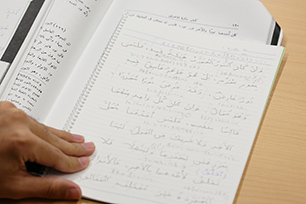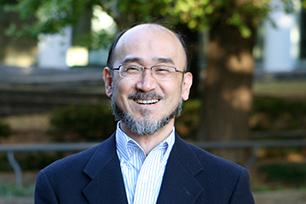Foreign Language at Keio University (1)

"I will study Dutch or any other language. If other people can learn it, I think I can too." (Excerpt from "I set out to learn Dutch in Nagasaki" in the Autobiography of Yukichi Fukuzawa)
This is the answer to a question addressed to nineteen-year-old Yukichi Fukuzawa in Nakatsu in 1854 (Ansei 1) when his older brother asked if he was willing to learn Dutch in order to read books on gunnery in their original language. At the time, Fukuzawa had never even seen the alphabet before. After diligent scholarship of Dutch in Nagasaki and Osaka, the Nakatsu Domain ordered a twenty-three-year-old Fukuzawa to open a school for Dutch studies in Edo. This school was the beginning of Keio University. The next year Fukuzawa reached a turning point when he found that his Dutch was useless as he interacted with foreigners while sightseeing in Yokohama. That was the moment he resolved to switch to English. After teaching himself English, at twenty-five he seized the opportunity to cross the Pacific aboard the Kanrin Maru as part of the delegation to the US.
In Fukuzawa's time, foreign languages were considered receptive languages, learned in order to acquire more advanced culture and technology. 150 years later, what significance does learning a foreign language now hold? Readers are encouraged to form their own opinions upon reading Professor Kazumi Sakai's thoughts on "languages of coexistence."
Currently courses in 23 languages listed below are offered at Keio University. In this feature, some of these courses will be introduced along with one of the summer schools available.
23 languages available for instruction at Keio University
English, German, French, Russian, Chinese, Spanish, Indonesian, Arabic, Italian, Korean, Vietnamese, Thai, Persian, Turkish, Cambodian, Sanskrit, Hebrew, Ancient Egyptian, Akkadian, Malay-Indonesian, Greek, Latin, Portuguese
*These languages are available for instruction at one or more of the following; Faculties, Research Center for Foreign Language Education, Foreign Language School, Institute of Cultural and Linguistic Studies.
*Language options vary by faculty.
What abilities should foreign language education develop?
Japanese monolingualism stems from an exclusive focus on English, but what is there to do when communication in English goes awry?
Plurilingual ability, pluricultural competence, and an open heart are all required of leaders in society.

Faculty of Economics
Director of the Keio Research Center for Foreign Language Education
Zeal for English Instruction and Declining Foreign Language Ability
English mania has taken China and Korea by storm, and the fever for English instruction shows no signs of abating. Not to be outdone, Japan's Ministry of Education, Culture, Sports, Science and Technology (MEXT) has proposed projects like the "Action Plan to Cultivate 'Japanese with English Abilities,'" which manifests itself in instruction guidelines which stress oral communication.
Accordingly, these measures seem to have yielded certain results in English. Conversely, the comprehensive foreign language ability of the future leaders of Japan--today's university graduates--has not improved over the past twenty years and may have even declined in some aspects. What this means is that students are losing opportunities to comprehend multiple languages and cultures, and therefore lose an edge in their ability to confront global diversity.
Double Monolingualism
One could argue that monolingualism has progressed among Japanese since the Deregulation of University Act of 1991, when many universities and departments made language instruction in a second foreign language optional and began to focus exclusively on English. Due to language education with little to no regard for languages other than English, learners' Japanese and English abilities are developed in isolation and without an opportunity to associate concepts with other languages. Experts call this "double monolingualism," which can be postured opposite the plurilingual ability fostered by language policies in Europe, where plurilingual ability as a whole is cultivated in an individual through mutual associations with other languages.
In an increasingly globalized world, interactions with individuals with different languages and cultures, either on the job or in daily life, will become more and more frequent. In fact, it is no longer rare to have non-Japanese neighbors here in Japan. However, English is not the mother tongue for the majority of these non-Japanese, and many do not even speak English. It would be great if everyone could use English to communicate, but how do we cope when English communication fails? I believe that this ability to cope is what is required of individuals today.
Language Instruction That Fosters an Open Mind
In a word, coping is keeping an open heart and mind. It is taking an interest in various languages and cultures, having the willingness to learn a little bit about them, and then taking action to learn and use them. An ideal situation might be the ability to try some broken Chinese if communication in English fails, and if that doesn't work, then to be able to try any one in a smörgåsbord of languages at your disposal. The other person might then try to tell you something in a smattering of Japanese. Isn't fostering this kind of mutual consideration what is required of contemporary foreign language education? Those with superior language skills should mediate for those who lack those skills. I believe that those who are to become leaders in society should be required to possess this sense of plurilingualism and pluricultural competence.
If foreign language learning was formerly "receptive" to adopt advanced culture and technology, and a shift to "dissemination" to assert one's interests happened twenty years ago, then isn't another shift necessary now, this time to "languages in coexistence"?
*Position titles, etc., are those at the time of publishing.
